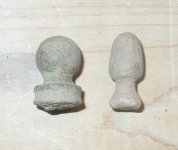gtoast99
Sr. Member
CW lead finial help?? solved - most likely carved bullet
Hey folks! I have a question for some of you Civil War diggers.
I found these two yesterday. The one on the left is obviously a brass cartridge box finial. The one on the right is made of lead. My first thought on digging it was that it was a lead cartridge box finial. I've found a similar but smaller lead cap box finial in the past, so that's why my mind jumped to that conclusion.
But it appears much more similar to a scabbard tip finial. So I tried to search for one, and I have found references to lead scabbard tips online, but no pics.
Still a third option that some have suggested is a carved bullet, but I seriously doubt that. It's rather small and looks designed that way to me. In addition, I don't see any evidence of knife marks or other signs of carving.
Thoughts??
Hey folks! I have a question for some of you Civil War diggers.
I found these two yesterday. The one on the left is obviously a brass cartridge box finial. The one on the right is made of lead. My first thought on digging it was that it was a lead cartridge box finial. I've found a similar but smaller lead cap box finial in the past, so that's why my mind jumped to that conclusion.
But it appears much more similar to a scabbard tip finial. So I tried to search for one, and I have found references to lead scabbard tips online, but no pics.
Still a third option that some have suggested is a carved bullet, but I seriously doubt that. It's rather small and looks designed that way to me. In addition, I don't see any evidence of knife marks or other signs of carving.
Thoughts??
Attachments
Last edited:







